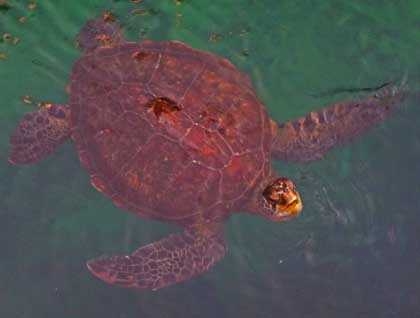Today we spent the entire day visiting the island of Santiago. This island, also known as San Salvador or James, is the fourth largest of the Galápagos Islands, with lush and green highlands and many sources of fresh water inland which made the island a favorite one among the first visitors such as pirates, buccaneers and later, whalers. The dramatic volcanic landscape with the long stretches of black basalt lava cliffs and soft tuff cone or lighter colors, shows evidence of having had volcanic activity in its recent past, perhaps in the last thousands of years.
Our visit started early this morning before breakfast, at Espumilla Beach, on the western coast of Santiago Island. This beach is one of the archipelago’s most important marine turtle nesting areas, as it was demonstrated by the numerous turtle tracks and nests found on the sand. Here we offered two walks, a fast paced walk inland and a photo walk along the beach. The trail inland took us under a canopy of big Palo Santo trees, passing by a small lagoon where a single flamingo was spotted in the company of several white checked pintails ducks. We enjoyed the beautiful scenery: endemic and native vegetation and many land birds such as Galápagos mockingbirds, flycatchers, doves and, of course, many Darwin finches. These sightings made our early walk very interesting, and it got more exciting at the end with the presence of several immature Galápagos hawks perched on the mangrove trees looking for an early snack.
Those who stayed on the beach had a fantastic time taking pictures of blue footed boobies fishing, dozens of elusive ghost crabs, pelicans and the very naive immature hawks. They gave us a particularly “special moment” when one of them decided to take one of the guest’s water shoes with him!
Everybody was amazed by the lack of fear these birds show in the presence of humans, something that makes the Galápagos a unique place on earth.
Back onboard during breakfast our little ship repositioned to explore the historical and scenic Buccaneer Cove. A one-time pirate haunt, it is also where Charles Darwin landed, spending a total of 9 days in Santiago, out of his five weeks in Galápagos.
After admiring this historical cove, we devoted the rest of the morning to a deep-water snorkeling excursion and a Zodiac ride along the coastline.
After lunch, we headed a short distance to the west to anchor at Puerto Egas. After some time relaxing, swimming and snorkeling on the black landing beach, we took a lovely nature walk of about 1.5 miles along the shoreline. We saw many coastal birds such as American Oystercatchers, Whimbrels, ruddy turnstones, plovers and many, many marine iguanas warming up on the shores. We also saw sea lions basking in the sun and a small colony of fur seals in the dramatic, deeply carved sea-level grottos at the end of the trail.
This was a full and gratifying day on our adopted island, which is now undergoing a very ambitious project to eradicate the introduced rats and eventually re-establish the original ecosystem, after the massive eradication of other introduced species such as goats, donkeys and feral pigs during the past years.







